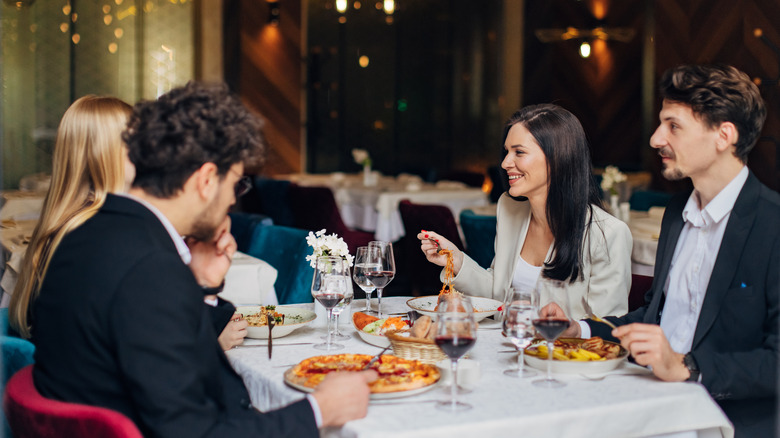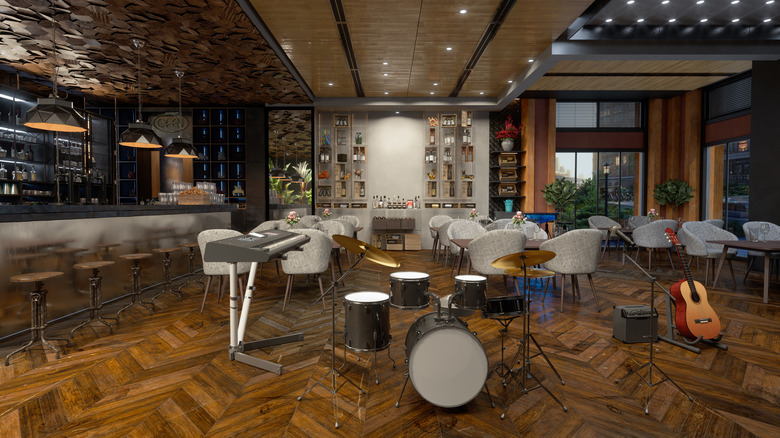How Restaurant Atmosphere Makes Food Literally Taste Better
When we talk about the flavor of food, we tend to ignore a vast majority of the factors that affect it. That's because our culinary conversations typically center on a single sense: taste. But in fact, all five senses have an impact on our perception of food. A truly thorough evaluation of dining must incorporate scent, texture, sound, and sight. There is an auditory appeal in crunchy foods and a visual appeal in well-presented dishes. Anyone who doubts the old saying that we eat with our eyes only needs to scroll through the gastronomic corners of Instagram and witness how their mouth waters at images alone. But the audio and visual aspects of food extend well beyond the boundaries of our plates. In fact, just about everything within reach of our senses has an impact on the flavor of our food.
"Atmosphere" is a critical term in the restaurant industry, one with far greater implications on the dining experience than the casual observer might know. You've probably noticed that certain types of restaurants have similar environments: Fast food restaurants are brightly lit, health food stores feature lots of green in their decor, and fine dining establishments are typically dimly lit with soft instrumental music in the background. None of these details are coincidental. Every aspect of a restaurant's environment is carefully selected by designers to influence the way you perceive their food and their business as a whole. Here are just some of the ways that atmosphere affects flavor.
Eating with your eyes
It is impossible to overstate the importance of a restaurant's visual presence, and one of the main ways for restaurant designers to utilize our sense of sight is through lighting. Ever wonder why fine dining restaurants have dim interiors? A study from Murray State University showed that, in certain circumstances, diminished atmospheric lighting can improve perceptions of taste. The effect is more profound when the food in question is dominated by a singular taste; for example, desserts, which are dominated by sweetness, were perceived more favorably in dim light. Researchers think the reason for this is that diminishing our sense of sight forces us to engage more with our sense of smell.
On the other end of the spectrum, a study published in Food Quality and Preference indicated that exposure to bright lights can make flavors seem more intense, but not necessarily better. The findings of these two studies show the importance of balanced lighting in ensuring that no particular taste becomes overwhelming to the diner.
Color is another visual factor that can affect our perception of food, and even increase our appetites. Have you noticed that fast food logos overwhelmingly feature red and yellow? Psychologists have linked the color red to desire, while yellow evokes happiness and comfort, according to Business Insider. Pairing the two on a fast food sign can spark a sense of yearning while simultaneously suggesting a happy environment in which to satisfy it.
The sound factor
Visual stimuli such as lighting and color have a significant impact on our perceptions of flavor, both in terms of its intensity and quality. However, the auditory atmosphere of a restaurant is equally as important. "Sound is the forgotten flavor sense," says Charles Spence, a psychology professor at Oxford University whose research into the effects of noise on dining has revealed a profound connection (via Science Friday). In one study, he found that diners who ate seafood while listening to the sound of waves enjoyed their food much more than diners who ate the same meal while listening to the sound of cutlery clinking. A restaurant's atmosphere should reflect the food they serve so that all of the diners' senses may be focused in the same direction.
Another paper published in Food Quality and Preference tested how the volume of background noise can affect flavor. Researchers found that loud background noises weaken our perception of sweet and salty flavors. In an interesting twist, even though their perception of sweetness was diminished, diners in loud environments reported greater pleasure from sweet foods. Researchers attribute this to the fact that a noisy atmosphere increases stress, which in turn increases our craving for sugar. Curiously, there is one particular flavor that becomes more intense in loud environments: umami. So the next time you're in a restaurant, pay close attention to the soundtrack and lighting, then see which flavors you experience the strongest.


